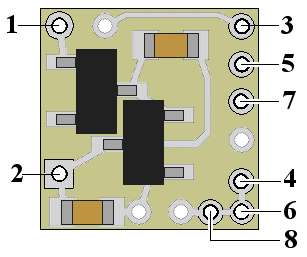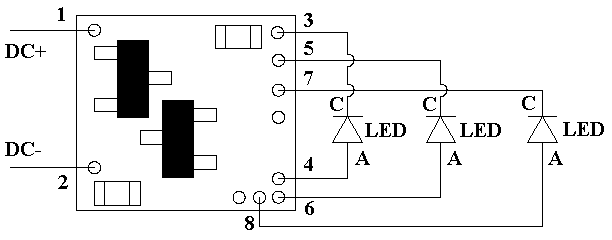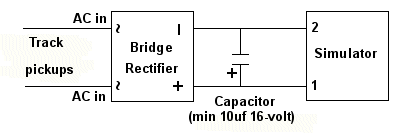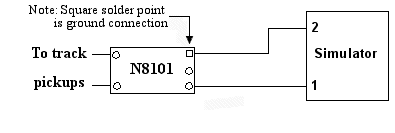Best viewed using:
Internet Explorer
or
Mozilla Firefox
Connecting the N8037 Early-era Flasher Simulator
Installing the N8037 is very straightforward. Because the module has circuitry on both sides, care must be taken to be sure that the components or wires soldered will not make contact with any metal object which could cause a short circuit.
Included with the module are two 6” lengths of #32 insulated wire. If necessary, these can be used for power input wires. If used, we recommend the blue wire be used for the + DC connection. It would be connected to solder point 1 as shown in Fig. 1. This wire could also connect through a switch to the + DC connection for remote control of the lighting effect. The other (green) wire should be connected to – DC and to solder point 2.
Any well regulated DC power source can be used to power this module providing the voltage is at least 6VDC and doesn't exceed 18VDC. Our N3512 and N3518 Power supplies are ideal for this use. Also, due to the very low power consumption, this device can also be powered by a battery, such as a standard 9-volt.

Figure 1
Important note: A low-wattage iron with a pointed tip should be used for connection of wires. Too much heat or solder can easily damage the wires, decoder or module and void the warranty.
Also, all connecting wires should be pre-tinned before soldering them to the module. This will make connection quick and easy and ensure excessive heat is not applied to the solder points.
Direct Track powering (without a decoder connection)
There may be situations where it is necessary to tap into track power to drive this Early-era Flasher Simulator. Two possible cases are: when it is located in rolling stock without a decoder (such as a passenger car, MOW car or caboose), or when it is located in stationary structure. All of our Simulators require a clean DC voltage of known polarity for their power source. Track power is typically provided in one of two forms. DC voltage (analog), or DCC.
Analog track power has been around for more than 75 years. Simply put, a DC voltage is applied to the two tracks with one being +DC and the other, -DC. Increase the voltage and the electric motor in the locomotive spins faster making the train go faster. If the train is required to reverse, track polarity is reversed so the loco's motor turns in reverse. Also, what defines "forward and reverse" is dependent on which way the loco is facing when it's put on the track. Bottom line here is that track polarity is not fixed. Our Simulator needs fixed polarity.
DCC track power is such that to devices requiring plain DC voltage, it looks like AC power. That is because voltage levels on each track go both + and – continuously. The DCC decoders in locomotives “descramble” the track signals and provide correct polarity so their motors can function normally. It is this process that will allow multiple locomotives to go in different directions on the same section of track, at the same time (a feature not available with analog track power). Once again, our Simulator needs fixed polarity and it needs to look like DC voltage.
Due to our Simulator's very small size, there is insufficient space to include additional circuitry and components necessary for proper power conditioning when direct track pickup is to be used. There are two solutions to this problem and both are inexpensive:
Discrete components
The Simulator can be powered from the track with the addition of two readily available components: a bridge rectifier (our N301S or N302S will work just fine). If DCC operation is used, the addition of a filter capacitor (10μf or larger and minimum 16-volt) will be required. Figure 2 below is schematic diagram of the connections required.
Figure 2
This is the least expensive solution, but is has a couple of minor drawbacks. First, the bridge rectifier (and capacitor, if needed) are not mounted on a circuit board so direct solder connection is required and you will need to ensure the pins on the rectifier and leads on the capacitor (depending on the type of capacitor) are organized so that they won't short out against anything. Second, depending on the physical size of the bridge selected (and capacitor, if needed) and the scale you're modeling, hiding these additional components so they're not noticeable can be a bit of a challenge.
N8101 DC Power Source
A more elegant, but very slightly more costly ($3.95) solution would be to use our N8101 DC Power Source. It has all of the components needed, includes a circuit board with solder points, is extremely tiny (1/2 the size of our Simulator), has the lowest possible voltage loss (important for analog operators). Click here for more information on the N8101. Figure 3 below is schematic diagram of the connections required.
Figure 3
Connecting LEDs
When connecting the LED, proper polarity must be observed. LEDs are “polarity sensitive” and will not function is connected backwards. The N8037 is configured to connect to a 20 ma LED with a device voltage of 1.85-2.0 VDC. This covers all of Ngineering’s Micro and Nano yellow and red LEDs, as well as many of the yellow and red LEDs available.
Using wire appropriate for the size of the LED, connect the LED cathode (the – connection) to point #3 on the module and connect the LED anode (the +) to solder point #4.
This module is configured with two (2) additional outputs ports to add extra flashing LEDs. Solder point #5 is the second output and point #7 is the third output. The three outputs (points 3, 5 & 7) are programmed to flash in sequence (3 first, 5 second, and 7 third, then back to 3 starting over). Flash timing on any one output is such that the repetition rate is that of a typical flashing early-era signal or hazard warning light.
If you wish to connect to the additional outputs use the same procedure as noted for solder points 3 & 4 above, only connect using points 5 & 6 and/or points 7 & 8. No additional (external) resistors are required because anode connection points 4, 6 & 8 share a common on-board resistor to protect the LEDs.
For any output, you can substitute a series-wired pair of LEDs if desired (see diagram of our Early-era Alternating Flasher for an example here). By doing this, this module will support a total of up to 6 LEDs. When using a series-wired pair of LEDs, the individual intensity (brightness) of these LEDs will be slightly lower than that of a single LED connected to the same solder points.
Figure 4 below is a schematic layout showing LED connection.

Figure 4
This completes connection of the N8037 Early-era Flasher module. It is recommended that a thorough re-inspection of all connections and module placement be performed prior to applying power. We hope you enjoy the added realism our module provides.
© 2008 Ngineering























